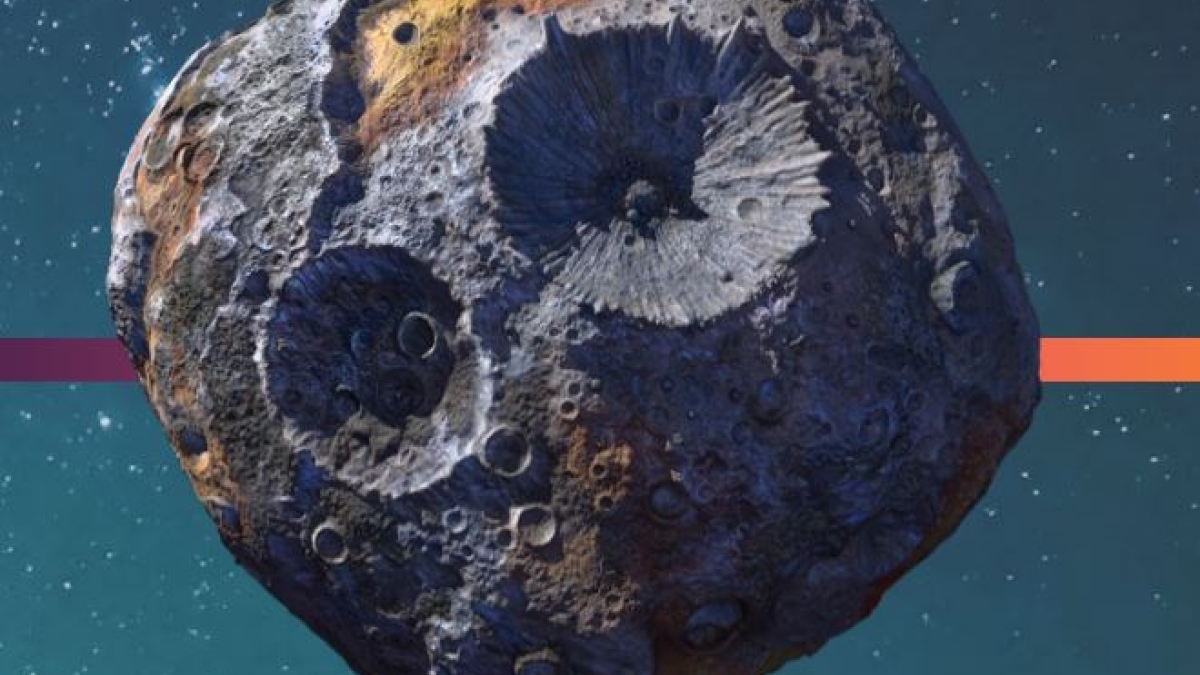ASU launches Psyche mission website
Psyche, NASA’s Discovery mission to a unique metal asteroid, has a new digital home at ASU

Psyche, an asteroid orbiting the sun between Mars and Jupiter, is made almost entirely of nickel-iron metal. As such, it offers a unique look into the violent collisions that created Earth and the terrestrial planets. Learn more about Psyche and the journey to a metal world at psyche.asu.edu. Image credit: ASU/Peter Rubin
Psyche, NASA’s Discovery mission to a unique metal asteroid, has a new digital home at ASU as of this week.
The ASU mission website, psyche.asu.edu, will be a resource for the public to learn about the mission, the spacecraft, the asteroid, the instruments being developed and the team behind the mission. The website also features a countdown clock, a mission timeline, the latest news, a blog, a photo library and details for upcoming events. The ASU mission website will complement NASA’s official Psyche Mission site.
“A major purpose of space exploration is to inspire everyone, everywhere, to stretch and think and be bolder,” said Lindy Elkins-Tanton, Psyche principal investigator and director of the School of Earth and Space Exploration. “This website is designed to give everyone an opportunity to not only learn about, but also participate in the mission.”
The site offers a variety of ways the public can get involved, including links to information about careers and internships, becoming a NASA Solar System Ambassador, and printing your own 3-D model of the asteroid and spacecraft.
For ASU students, the site features information on Psyche mission-centered senior capstone projects, as well as a multidisciplinary arts program called “Psyche Inspired,” where undergraduate students can use their creative talents from photography to ceramics to share the excitement for Psyche with the public. Both of these programs are being piloted at ASU and will be available nationally next academic year.
“We encourage everyone to visit the ‘Get Involved’ section to learn about existing NASA programs and internships, as well as connect with special Psyche opportunities we are developing,” said Cassie Bowman, Psyche co-investigator and student collaboration lead. “Through our Psyche-specific programs, everyone can learn about and contribute to the excitement, innovation, and scientific and engineering content of the mission both at school and at home.”
The Psyche mission
Psyche, an asteroid orbiting the sun between Mars and Jupiter, is made almost entirely of nickel-iron metal. As such, it offers a unique look into the violent collisions that created Earth and the terrestrial planets.
The Psyche spacecraft is targeted to launch in August 2022 and travel to the asteroid using solar-electric (low thrust) propulsion, arriving in 2026, following a Mars flyby and gravity-assist in 2023. After arrival, the mission plan calls for 21 months orbiting the asteroid, mapping it and studying its properties.
The scientific goals of the Psyche mission are to understand the building blocks of planet formation and explore first-hand a wholly new and unexplored type of world. The mission team seeks to determine whether Psyche is the core of an early planet, how old it is, whether it formed in similar ways to the Earth's core, and what its surface is like.
The spacecraft's instrument payload will include a magnetometer, a multispectral imager, and a gamma ray and neutron spectrometer. The mission will use an X-band radio telecommunications system and will test a sophisticated new laser communications technology, called Deep Space Optical Communications (DSOC) that encodes data in photons.
The Psyche Mission was selected for flight under NASA's Discovery Program, a series of lower-cost, highly focused robotic space missions that are exploring the solar system. The Psyche Mission’s principal investigator, Lindy Elkins-Tanton, is the director of the School of Earth and Space Exploration. In addition to Elkins-Tanton, ASU researchers on the Psyche mission team include Jim Bell (deputy principal investigator and co-investigator), David Williams (co-investigator), and Catherine Bowman (co-investigator).
The NASA mission is led by Arizona State University. NASA’s Jet Propulsion Laboratory is responsible for mission management; spacecraft assembly, test, and launch operations; mission operations; and navigation. The spacecraft’s solar-electric propulsion chassis will be built by SSL.
For additional resources about the mission, visit https://www.jpl.nasa.gov/missions/psyche and https://www.nasa.gov/psyche.
More Science and technology

New AI for a new era of discovery
As the legend goes, in 1665, Sir Isaac Newton sat in his garden at Woolsthorpe Manor in England and looked on as a lone apple…

ASU receives 3 awards for research critical to national security
Three researchers in the Ira A. Fulton Schools of Engineering at Arizona State University have received grant awards under the …

Celebrating 34 years of space discovery with NASA
This year, NASA's Hubble Space Telescope (HST) is celebrating its 34th anniversary of the world's first space-based optical…